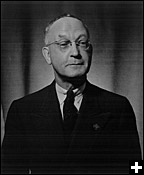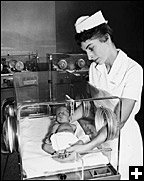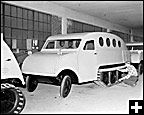Common menu bar links
Canadian Statistics in 1955
Archived Content
Information identified as archived is provided for reference, research or recordkeeping purposes. It is not subject to the Government of Canada Web Standards and has not been altered or updated since it was archived. Please contact us to request a format other than those available.

On October 17, 1945, Sedley A. Cudmore— Dominion Statistician since 1942 and a previous editor of the Canada Year Book—died suddenly at age 66. His successor, a pioneering Canadian economist named Herbert Marshall, was made Dominion Statistician the day after Cudmore’s death.
One of his first significant acts as Dominion Statistician was to strengthen the bureau’s mandate through the new Statistics Act of 1948 and modernized the bureau’s programs and management.
Under Marshall, the Dominion Bureau of Statistics expanded its national presence.
As new government programs and extended client lists required more of the Dominion Bureau of Statistics, the regional offices grew. Five regional offices—Halifax, Montréal, Toronto, Winnipeg and Vancouver—were established in 1945; another was established in St. John’s, Newfoundland, in 1949; and two more were established in Edmonton and Ottawa–Hull in 1952.
Marshall’s steps to modernize and develop the bureau’s statistical programs quickly earned him the title of Canada’s ‘Statistical Tzar.’ In 1952, under Marshall’s direction, the Dominion Bureau of Statistics’ central office moved to Tunney’s Pasture, into the newly constructed Main Building, where it has remained to this day.
Co-ordinating statistics for social welfare
In the aftermath of the Second World War, the government created new social programs to make Canadian society a “prosperous but caring postwar society.” A new division, the Health and Welfare Division, was established at the bureau. Conferences were held to ensure that existing statistical programs met the information needs of the government and the public. These conferences helped monitor the effects of the postwar measures, and included topics such as vital, hospital, criminal, agricultural, financial and economic statistics.
Postwar statistical programs

Canada needed to closely monitor the economy after the war to make sure the country did not return to the conditions of the Great Depression. In 1945 the Dominion Bureau of Statistics developed tools to examine national income and expenditure accounts, including gross national product. Another tool, the cost of living index, was broadened in scope and renamed the Consumer Price Index in 1949. The new index was first issued in 1952.
Canada also needed more regular and timely reports on the characteristics of the population and labour force to “monitor the effects of the policies and programs of postwar reconversion and reconstruction.” To help with this, the bureau introduced sampling, which is when a representative part of the population is surveyed instead of the entire population. The quarterly Canadian Labour Force Survey, conducted for the first time in 1945, was the first survey to use sampling.
These, and many more of the bureau’s activities, were discussed in the 1955 edition of the Canada Year Book.
The Canada Year Book branches out
The 1955 edition of the Canada Year Book was produced by John F. McVea, assistant editor of the book. The book’s purpose was “to reveal the interrelationship of the various sectors of the economy and portray within a single volume the essential economic and social elements in the progress of Canada.”
As wartime censorship and resource shortages lessened after 1945, the number of publications grew. An Advisory Board of Publications was created in 1948 to review and eliminate unnecessary publications; make improvements to layout, tables and related text; and promote “uniform editorial and production standards across the bureau.”
As a result, by the 1950s the Department of Public Printing and Stationary distributed all the publications of other government departments; however, the Dominion Bureau of Statistics felt that it could do a better job than the department in distributing its own publications. With the exception of select publications, like the Canada Year Book, which were jointly produced between the bureau and the department, the bureau distributed the great majority of its own reports.
A postwar population

In 1952, there were 402,527 live births and 125,950 deaths in the country, compared with 380,101 live births and 125,454 deaths the previous year. By 1952 Canada’s birth rate hit a peak at 19.2 per 1,000 people. Historically, Quebec almost always had the highest birth rate in Canada, but in 1952 its birth rate was surpassed by that of Newfoundland and New Brunswick, at 33.6 per 1,000 and 31.7 per 1,000, respectively.
By 1954, the estimated population of Canada was 15,195,000 people. The 1955 edition of the Canada Year Book reported that “as of June 30, 1954, the total number of immigrants entering since Jan. 1, 1946, was 1,043,911.”
Counting amenities

From 1943 to 1952, there was an increase of 1.6 million telephones in the country. In 1953, Canada’s first microwave radio relay system, reaching from Toronto through Ottawa to Montréal, was opened, allowing many telephone conversations and television programs to take place at the same time. Also, by July 1954, there were more than 800,000 television sets in Canadian homes, compared with 146,000 just two years earlier.
With the end of the war, restrictions on passenger car manufacture and the rationing of tires and gasoline were lifted. By 1953, there were 3.4 million motor vehicle registrations in Canada, which “included 2,513,754 passenger cars and taxis, 867,773 trucks and miscellaneous vehicles, 8,968 buses and 40,177 motorcycles.”
National accounting and more

Most striking among the postwar statistics were the national account totals.
In 1953, Canada’s national income was $19 million and its gross national expenditure and gross national product were both $24 million. While personal income had risen to $18 million in 1953, personal expenditure on consumer goods and services—most prominently, food, shelter, transportation, and personal and medical care and death expenses—had also risen, from $14 million in 1952 to $15 million in 1953.
The Cold War comes to Canada
The 1955 edition of the Canada Year Book shows the effects of the Cold War on Canada—regardless of the end of the Second World War, the “strengths of the active forces of the three Services have continued to increase to keep pace with defence objectives and commitments. At June 30, 1954, the total active force strength was 113,958 composed of: Navy, 17,251; Army, 49,851; and Air Force, 46,856. The strength of the reserve elements of the three Services was 56,421.”
